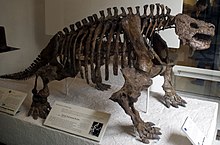
An anapsid is an amniote whose skull does not have openings (fenestra) near the temples. Traditionally, the Anapsida are the most primitive subclass of reptiles, the ancestral stock from which Synapsida and Diapsida evolved, making anapsids paraphyletic. It is however doubtful that all anapsids lack temporal fenestra as a primitive trait, and that all the groups traditionally seen as anapsids truly lacked fenestra.
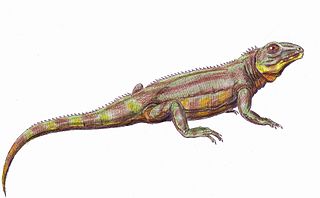
Bolosauridae is an extinct family of ankyramorph parareptiles known from the latest Carboniferous (Gzhelian) or earliest Permian (Asselian) to the early Guadalupian epoch of North America, China, Germany, Russia and France. The bolosaurids were unusual for their time period by being bipedal, the oldest known tetrapods to have been so. Their teeth suggest that they were herbivores. The bolosaurids were a rare group and died out without any known descendants. The following cladogram shows the phylogenetic position of the Bolosauridae, from Johannes Müller, Jin-Ling Li and Robert R. Reisz, 2008.

The Procolophonia are a suborder of herbivorous reptiles that lived from the Middle Permian till the end of the Triassic period. They were originally included as a suborder of the Cotylosauria but are now considered a clade of Parareptilia. They are closely related to other generally lizard-like Permian reptiles such as the Millerettidae, Bolosauridae, Acleistorhinidae, and Lanthanosuchidae, all of which are included under the Anapsida or "Parareptiles".
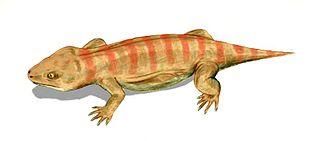
Procolophonomorpha is an order or clade of early reptiles that appeared during the Middle Permian. It constitutes a diverse assemblage that includes a number of lizard-like forms, as well as more diverse types such as the pareiasaurs. The most important subclade, Procolophonia, is traditionally thought to be ancestral to turtles. Lee 1995, 1996, 1997 argues that turtles evolved from pareiasaurs, but this view is by no means held unanimously. Rieppel and deBraga 1996 and deBraga and Rieppel, 1997 argue that turtles evolved from sauropterygians.
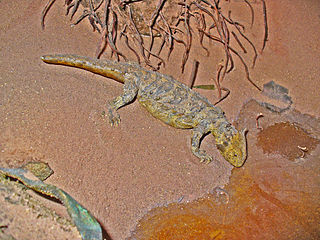
Procolophonidae is an extinct family of parareptiles from the Permian and Triassic periods.

Nyctiphruretus is an extinct genus of nyctiphruretid parareptile known from the Guadalupian series of European Russia.

Belebey is an extinct genus of bolosaurid ankyramorph parareptile containing species known from the latest Carboniferous (Gzhelian) or earliest Permian (Asselian) to Guadalupian stage of Europe and Asia (China).

Macroleter is an extinct genus of nycteroleterid parareptile which existed in Oklahoma and Russia during the upper Permian period. It was a quite generalized primitive reptile, in many ways resembling their amphibian ancestors. It was first named by paleontologists Tverdochlebova and Ivachnenko in 1984. According to classification by Michel Laurin and Robert R. Reisz, the genus is a parareptile, belonging to the same branch as Millerettidae, Procolophonidae and other generalized anapsid reptiles. The type species is Macroleter poezicus from Upper Permian of Russia.

Leptoropha is an extinct genus of aquatic seymouriamorph reptiliomorphs known from the Middle Permian of Russia.
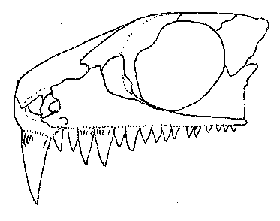
Colobomycter is an extinct genus of small parareptile known from the Early Permian of Oklahoma. The genus was first described from fossil remains in 1958, at which time it was believed to represent a synapsid, specifically, a pelycosaur. However, the discovery of new material and reexamination of the holotype led to its reclassification as a member of the Eureptilia. More recent studies indicate that Colobomycter is properly placed within the amniote clade Parareptilia, closely related to the taxon Acleistorhinus. Together, the two taxa form the Family Acleistorhinidae.

Delorhynchus is an extinct genus of lanthanosuchoid parareptile known from the late Early Permian Garber Formation of Comanche County, Oklahoma, south-central United States. It contains the type species D. priscus as well as a better preserved second species D. cifellii.

Acleistorhinidae is an extinct family of Early Permian-aged lanthanosuchoid parareptiles. Presently, the clade consists of only two taxa, Colobomycter and Acleistorhinus, both collected from the Permian of Oklahoma. Sister taxa include Chalcosaurus, Lanthaniscus and Lanthanosuchus.

Acleistorhinus (ah-kles-toe-RYE-nuss) is an extinct genus of parareptile known from the Early Permian of Oklahoma It is notable for being the earliest known anapsid reptile yet discovered. The morphology of the lower temporal fenestra of the skull of Acleistorhinus bears a superficial resemblance to that seen in early synapsids, a result of convergent evolution. Only a single species, A. pteroticus, is known, and it is classified in the Family Acleistorhinidae, along with Colobomycter.
Baeotherates is an extinct genus of Early Permian captorhinid reptile known from Oklahoma, United States.
Nyctiphruretidae is an extinct family of hallucicranian parareptiles known from the late Early to the late Middle Permian of European Russia and south-central United States.
Lanthaniscus is an extinct genus of lanthanosuchoid ankyramorph parareptile known from the Guadalupian epoch of Eastern Europe, Russia. Lanthaniscus was first named by M. F. Ivakhnenko in 1980 and the type species is Lanthaniscus efremovi. L. efremovi was originally described on the basis of the holotype PIN 3706/9 from Peza-1 locality, Krasnoshchel' Formation, of Arkhangelsk. Various authors had assigned it to the family Lanthanosuchidae, however Ivakhnenko who described an additional specimen of L. efremovi in 2008, assigned Lanthaniscus to its own family, the Lanthaniscidae. The additional specimen PIN 4543/2, was collected from the same formation as the holotype, from the Nisogora locality, which is slightly younger in age.

Pareiasauromorpha is a group of parareptilian amniotes from the Permian. It includes genera found all over the world, with many genera from Asia and South Africa. The clade was first used as a group by Linda A. Tsuji in 2011, in order to group the family Nycteroleteridae (nycteroleters) and the superfamily Pareiasauroidea (pareiasaurs). Pareiasauromorpha is considered to be a monophyletic node, the sister group to procolophonoids.
Abyssomedon is an extinct genus of a nyctiphruretid parareptile known from the late Early Permian Garber Formation of Comanche County, Oklahoma, south-central United States. It contains a single species, Abyssomedon williamsi, which represents the third known nyctiphruretid species, the oldest species of the family and the first to be discovered in North America.

